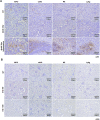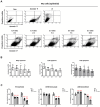Observation of neutrophil extracellular traps in the development of diabetic nephropathy using diabetic murine models
- PMID: 39506804
- PMCID: PMC11542270
- DOI: 10.1186/s42826-024-00226-2
Observation of neutrophil extracellular traps in the development of diabetic nephropathy using diabetic murine models
Abstract
Background: Diabetic nephropathy (DN) is a progressive complication among patients with diabetes and the most common cause of end-stage kidney disease. Neutrophil extracellular traps (NETs) are known to play a role in kidney disease, thus this study aimed to determine their role in the development of diabetic kidney disease using diabetic murine models.
Results: Protein and histological analyses revealed that db/db mice and streptozotocin DN models expressed no significant NET-related proteins, myeloperoxidase, citrullinated histone H3 (citH3), neutrophil elastase, and lymphocyte antigen 6 complex locus G6D (Ly6G). However, the inflamed individuals in the DN model showed that citH3 and Ly6G were highly deposited in the renal system based on immunohistochemistry images. In vitro, NET treatment did not induce apoptosis in glomerular endothelial and renal tubular epithelial cells. NET inhibition by DNase administration demonstrated no significant changes in cell apoptosis.
Conclusions: NET-related proteins were only expressed in the DN model with tubulointerstitial inflammation. Our study revealed that NETs are only induced in mice with hyperglycemia-induced inflammation.
Keywords: Chronic kidney disease; Diabetic nephropathy; Hyperglycemia; Neutrophil; Neutrophil extracellular traps.
© 2024. The Author(s).
Conflict of interest statement
The authors declare no competing interests.
Figures




References
-
- Chatterjee S, Khunti K, Davies MJ. Type 2 diabetes. Lancet. 2017;389(10085):2239–51. - PubMed
-
- Thomas MC, Cooper ME, Zimmet P. Changing epidemiology of type 2 diabetes mellitus and associated chronic kidney disease. Nat Rev Nephrol. 2016;12(2):73–81. - PubMed
-
- Saeedi P, Petersohn I, Salpea P, Malanda B, Karuranga S, Unwin N, et al. Global and regional diabetes prevalence estimates for 2019 and projections for 2030 and 2045: results from the International Diabetes Federation Diabetes Atlas, 9(th) edition. Diabetes Res Clin Pract. 2019;157:107843. - PubMed
Grants and funding
LinkOut - more resources
Full Text Sources
Research Materials
Miscellaneous

